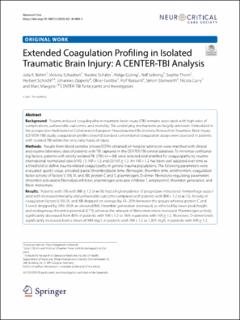Extended Coagulation Profling in Isolated Traumatic Brain Injury: A CENTER-TBI Analysis
| dc.contributor.author | Böhm, Julia K. | |
| dc.contributor.author | Schaeben, Victoria | |
| dc.contributor.author | Schäfer, Nadine | |
| dc.contributor.author | Güting, Helge | |
| dc.contributor.author | Lefering, Rolf | |
| dc.contributor.author | Thorn, Sophie | |
| dc.contributor.author | Schöchl, Herbert | |
| dc.contributor.author | Zipperle, Johannes | |
| dc.contributor.author | Grottke, Oliver | |
| dc.contributor.author | Rossaint, Rolf | |
| dc.contributor.author | Stanworth, Simon | |
| dc.contributor.author | Curry, Nicola | |
| dc.contributor.author | Maegele, Mark | |
| dc.contributor.author | Andelic, Nada | |
| dc.contributor.author | Andreassen, Lasse | |
| dc.contributor.author | Anke, Audny Gabriele Wagner | |
| dc.contributor.author | Frisvold, Shirin | |
| dc.contributor.author | Helseth, Eirik | |
| dc.contributor.author | Røe, Cecilie | |
| dc.contributor.author | Røise, Olav | |
| dc.contributor.author | Skandsen, Toril | |
| dc.contributor.author | Vik, Anne | |
| dc.contributor.author | Åkerlund, Cecilia | |
| dc.contributor.author | Amrein, Krisztina | |
| dc.contributor.author | Antoni, Anna | |
| dc.contributor.author | Audibert, Gerard | |
| dc.contributor.author | Azouvi, Philippe | |
| dc.contributor.author | Azzolini, Maria luisa | |
| dc.contributor.author | Bartels, Ronald | |
| dc.contributor.author | Barzo, Pal | |
| dc.contributor.author | Beauvais, Romuald | |
| dc.contributor.author | Beer, Ronny | |
| dc.contributor.author | Bellander, Bo-michael | |
| dc.contributor.author | Belli, Antonio | |
| dc.contributor.author | Benali, Habib | |
| dc.contributor.author | Berardino, Maurizio | |
| dc.contributor.author | Beretta, Luigi | |
| dc.contributor.author | Blaabjerg, Morten | |
| dc.contributor.author | Bragge, Peter | |
| dc.contributor.author | Brazinova, Alexandra | |
| dc.contributor.author | Brinck, Vibeke | |
| dc.contributor.author | Brooker, Joanne | |
| dc.contributor.author | Brorsson, Camilla | |
| dc.contributor.author | Buki, Andras | |
| dc.contributor.author | Bullinger, Monika | |
| dc.contributor.author | Cabeleira, Manuel | |
| dc.contributor.author | Caccioppola, Alessio | |
| dc.contributor.author | Calvi, Maria rosa | |
| dc.contributor.author | Cameron, Peter | |
| dc.contributor.author | Lozano, Guillermo carbayo | |
| dc.contributor.author | Carbonara, Marco | |
| dc.contributor.author | Chevallard, Giorgio | |
| dc.date.accessioned | 2022-03-04T09:38:33Z | |
| dc.date.available | 2022-03-04T09:38:33Z | |
| dc.date.created | 2022-02-20T23:28:02Z | |
| dc.date.issued | 2021 | |
| dc.identifier.citation | Neurocritical Care. 2021, . | en_US |
| dc.identifier.issn | 1541-6933 | |
| dc.identifier.uri | https://hdl.handle.net/11250/2983042 | |
| dc.description.abstract | Background Trauma-induced coagulopathy in traumatic brain injury (TBI) remains associated with high rates of complications, unfavorable outcomes, and mortality. The underlying mechanisms are largely unknown. Embedded in the prospective multinational Collaborative European Neurotrauma Effectiveness Research in Traumatic Brain Injury (CENTER-TBI) study, coagulation profiles beyond standard conventional coagulation assays were assessed in patients with isolated TBI within the very early hours of injury. Methods Results from blood samples (citrate/EDTA) obtained on hospital admission were matched with clinical and routine laboratory data of patients with TBI captured in the CENTER-TBI central database. To minimize confounding factors, patients with strictly isolated TBI (iTBI) (n = 88) were selected and stratified for coagulopathy by routine international normalized ratio (INR): (1) INR < 1.2 and (2) INR ≥ 1.2. An INR > 1.2 has been well adopted over time as a threshold to define trauma-related coagulopathy in general trauma populations. The following parameters were evaluated: quick’s value, activated partial thromboplastin time, fibrinogen, thrombin time, antithrombin, coagulation factor activity of factors V, VIII, IX, and XIII, protein C and S, plasminogen, D-dimer, fibrinolysis-regulating parameters (thrombin activatable fibrinolysis inhibitor, plasminogen activator inhibitor 1, antiplasmin), thrombin generation, and fibrin monomers. Results Patients with iTBI with INR ≥ 1.2 (n = 16) had a high incidence of progressive intracranial hemorrhage associated with increased mortality and unfavorable outcome compared with patients with INR < 1.2 (n = 72). Activity of coagulation factors V, VIII, IX, and XIII dropped on average by 15–20% between the groups whereas protein C and S levels dropped by 20%. With an elevated INR, thrombin generation decreased, as reflected by lower peak height and endogenous thrombin potential (ETP), whereas the amount of fibrin monomers increased. Plasminogen activity significantly decreased from 89% in patients with INR < 1.2 to 76% in patients with INR ≥ 1.2. Moreover, D-dimer levels significantly increased from a mean of 943 mg/L in patients with INR < 1.2 to 1,301 mg/L in patients with INR ≥ 1.2. Conclusions This more in-depth analysis beyond routine conventional coagulation assays suggests a counterbalanced regulation of coagulation and fibrinolysis in patients with iTBI with hemostatic abnormalities. We observed distinct patterns involving key pathways of the highly complex and dynamic coagulation system that offer windows of opportunity for further research. Whether the changes observed on factor levels may be relevant and explain the worse outcome or the more severe brain injuries by themselves remains speculative. | en_US |
| dc.language.iso | eng | en_US |
| dc.publisher | Springer | en_US |
| dc.rights | Navngivelse 4.0 Internasjonal | * |
| dc.rights.uri | http://creativecommons.org/licenses/by/4.0/deed.no | * |
| dc.title | Extended Coagulation Profling in Isolated Traumatic Brain Injury: A CENTER-TBI Analysis | en_US |
| dc.type | Peer reviewed | en_US |
| dc.type | Journal article | en_US |
| dc.description.version | publishedVersion | en_US |
| dc.source.pagenumber | 15 | en_US |
| dc.source.journal | Neurocritical Care | en_US |
| dc.identifier.doi | 10.1007/s12028-021-01400-3 | |
| dc.identifier.cristin | 2003854 | |
| cristin.ispublished | true | |
| cristin.fulltext | original | |
| cristin.qualitycode | 1 |

